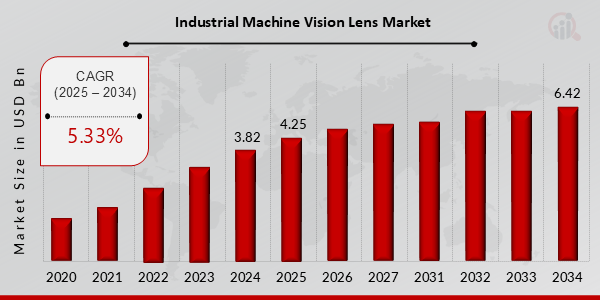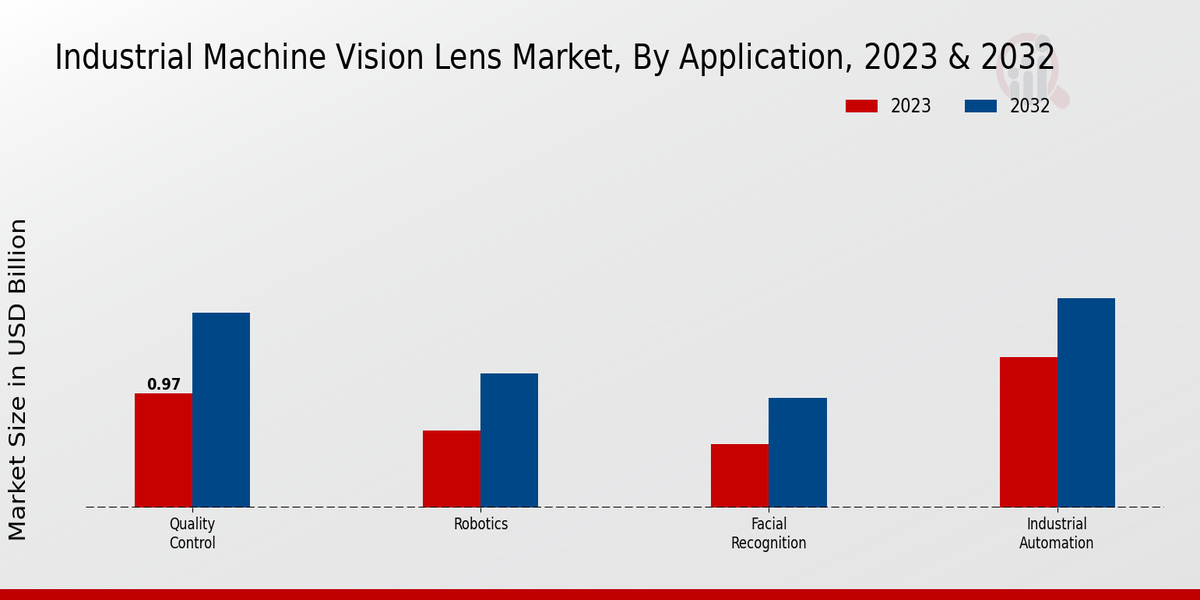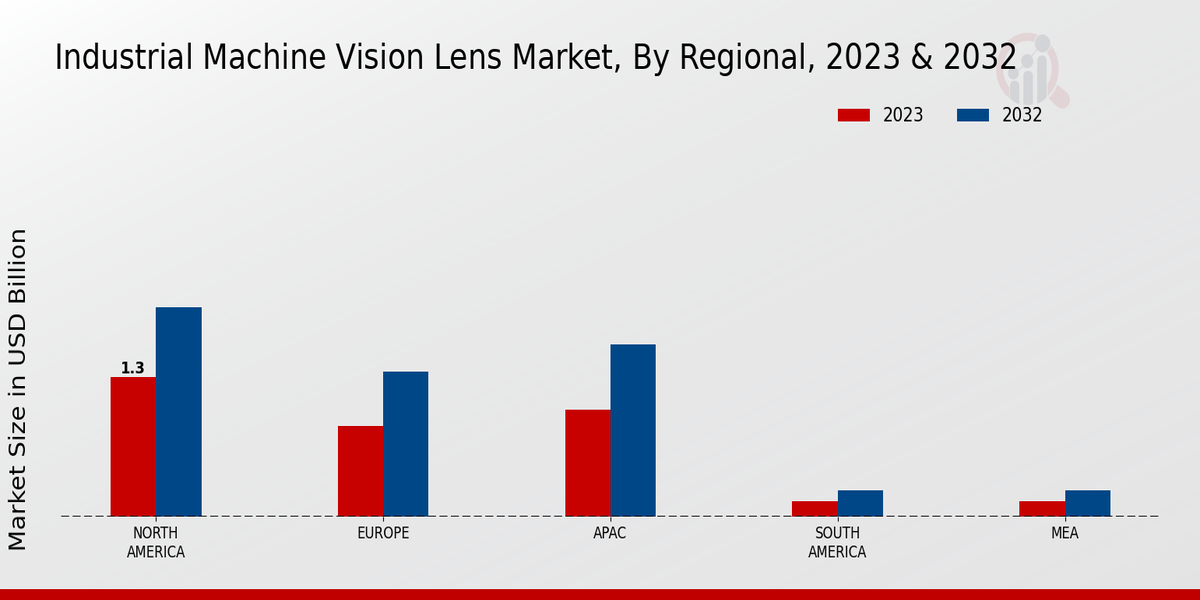Global Industrial Machine Vision Lens Market Overview:
Industrial Machine Vision Lense Market Size was estimated at 3.82 (USD Billion) in 2024. The Industrial Machine Vision Lense Market Industry is expected to grow from 4.25 (USD Billion) in 2025 to 6.42 (USD Billion) till 2034, exhibiting a compound annual growth rate (CAGR) of 5.33% during the forecast period (2025 - 2034).
Key Industrial Machine Vision Lens Market Trends Highlighted
The Industrial Machine Vision Lens Market is significantly driven by several factors. Increasing automation across various manufacturing sectors is pushing the demand for machine vision systems, which rely heavily on high-quality lenses to ensure accurate imaging and inspection. The growing need for quality control and inspection in industries such as automotive, electronics, and pharmaceuticals contributes to sustained market growth. Additionally, advancements in lens technology, such as improvements in resolution and optical clarity, enhance the efficiency of machine vision systems, making them more appealing to manufacturers seeking to optimize production processes.There are numerous opportunities to be explored in the market.
The expanding adoption of artificial intelligence and deep learning technologies in vision processing has created a need for advanced lenses that can deliver exceptional performance and support enhanced capability.
Emerging markets, particularly in Asia-Pacific, show a growing trend in the adoption of industrial automation, presenting new avenues for machine vision lens manufacturers. Furthermore, innovations in lens design and integration with other imaging technologies are paving the way for the creation of more sophisticated machine vision solutions, which can cater to a broader range of applications.Recently, the trend toward smart manufacturing and Industry 4.0 has gained traction, further influencing the machine vision lens market. Companies are increasingly integrating machine vision systems with IoT devices, which enhances the functionality and connectivity of these systems.
This shift is leading to the development of more compact and efficient lenses designed to meet the requirements of automated processes. The ongoing focus on sustainability and lowering environmental impacts is also encouraging manufacturers to develop lenses that consume less energy and resource-efficient materials. As these trends continue to evolve, they are likely to shape the future landscape of the Industrial Machine Vision Lens Market.

Source: Primary Research, Secondary Research, MRFR Database and Analyst Review
Industrial Machine Vision Lens Market Drivers
Increasing Automation in Manufacturing
The Industrial Machine Vision Lens Market Industry is witnessing a significant push for automation in various manufacturing processes. Automation helps to enhance productivity, efficiency, and overall performance in production environments. Machine vision systems, complemented by advanced lenses, play a crucial role in this transition. They allow for precise inspections, measurements, and quality control, ensuring that products meet stringent quality standards.As manufacturers increasingly adopt automated solutions to streamline operations and reduce human error, the demand for specialized lenses within machine vision systems is set to rise.
The integration of these products into robotics, assembly lines, and inspection systems will significantly influence market growth, especially as industries strive to keep pace with global competition. This trend is expected to continue as businesses recognize the substantial return on investment associated with automation technology that leverages sophisticated imaging solutions.Consequently, the ongoing evolution toward higher levels of automation represents a key driver for growth in the Industrial Machine Vision Lens Market, indicating a robust future as industries adopt more innovative technologies.
Growing Demand for Quality Assurance
With heightened emphasis on quality assurance across various industries, the Industrial Machine Vision Lens Market Industry is positioned to experience significant growth. Companies are increasingly focused on delivering high-quality products to meet consumer expectations and regulatory requirements. Machine vision systems equipped with advanced lenses provide the necessary tools for accurate inspections, defect detection, and process optimization.The increasing reliance on these technologies to ensure compliance with industry standards and improve customer satisfaction is driving demand for industrial machine vision lenses.
This growing trend underscores the critical importance of investing in high-performance imaging solutions, which is expected to create new opportunities for market participants.
Technological Advancements in Imaging Solutions
Rapid advancements in imaging technologies are transforming the Industrial Machine Vision Lens Market Industry landscape. Innovations such as high-resolution sensors, optical coatings, and specialized lens designs are enhancing the capabilities and performance of machine vision systems. These developments enable manufacturers to achieve higher accuracy, faster processing speeds, and improved image quality. As industries explore new applications for machine vision, the demand for advanced lens systems that can accommodate various operating conditions and requirements is on the rise.The integration of artificial intelligence and machine learning into imaging technologies further propels this trend, empowering machines to analyze visual data effectively.
The consistent evolution of imaging technologies signifies an essential driver for market growth, as businesses seek to implement cutting-edge solutions that ensure operational efficiency and product quality.
Industrial Machine Vision Lens Market Segment Insights:
Industrial Machine Vision Lens Market Application Insights
The Industrial Machine Vision Lens Market is witnessing remarkable growth within its Application segment, reflecting a diverse range of utilities across various industrial sectors. Quality Control emerged as a major application, attaining a valuation of 0.969 USD Billion in 2023, and is projected to grow significantly to 1.65 USD Billion by 2032, highlighting its essential role in maintaining production standards and enhancing product reliability. Robotics, another crucial application, commands a notable market presence with a valuation of 0.659 USD Billion in 2023, which is expected to rise to 1.142 USD Billion in 2032, driven by increasing automation in manufacturing processes.
This growth is primarily fueled by the ongoing demand for efficiency and precision in robotic applications, showcasing its significant impact on operational excellence.
Facial Recognition is also contributing positively to the market dynamics, with a valuation of 0.543 USD Billion in 2023, growing to 0.931 USD Billion in 2032. This application reflects the rising importance of security and identification technologies across various sectors, emphasizing its relevance in today's safety-conscious environment. Furthermore, Industrial Automation is the leadingsegment within the Industrial Machine Vision Lens Market, valued at 1.279 USD Billion in 2023 and projected to reach 1.777 USD Billion by 2032.
This application is crucial as it underscores the trend of integrating machine vision systems into production lines for enhanced monitoring and control, ultimately leading to optimized production processes.
Overall, the market segmentation reveals a trend where Quality Control and Industrial Automation dominate the landscape, collectively holding a significant share of the overall market revenue, contributing to their status as major drivers of growth in the Industrial Machine Vision Lens Market. The segmentation data illustrates how the demand for advanced technology in quality assurance and industrial operations is shaping the market while also presenting opportunities for innovation and expansion across other application areas.
As industries continue to pursue greater efficiencies and enhanced safety measures, the market is expected to sustain its upward trajectory, driven by evolving technological advancements and a growing emphasis on automation and precision across various sectors.

Source: Primary Research, Secondary Research, MRFR Database and Analyst Review
Industrial Machine Vision Lens Market Type Insights
The Industrial Machine Vision Lens Market has been classified into several types, reflecting the diverse needs of various applications in the industry. In 2023, the overall market was valued at 3.45 billion USD, showcasing robust growth potential. Telecentric lenses are gaining traction due to their unique capability to maintain consistent magnification and minimize perspective errors, making them essential for measurement applications. F-Mount lenses offer versatility and are widely adopted for different imaging systems, while C-Mount lenses continue to dominate in compact camera setups due to their compatibility and ease of integration.
Liquid lenses, although newer to the market, show significant promise with their adjustable focus characteristics, catering to advanced vision systems requiring dynamic focus adjustments. Each type plays a crucial role in enhancing operational efficiency, contributing to the overall Industrial Machine Vision Lens Market revenue, with diverse demand across sectors driving continuous innovation and growth.
Market trends indicate that increasing automation and advancements in imaging technology present substantial opportunities for expansion within these segments.The challenges of integrating new technologies and the need for precise imaging solutions further underscore the importance of these lens types in the Industrial Machine Vision Lens Market industry.
Industrial Machine Vision Lens Market End Use Insights
The Industrial Machine Vision Lens Market enjoys robust growth across various end-use industries, contributing significantly to a projected market value of 3.45 USD Billion in 2023. The manufacturing sector plays a crucial role in pacesetting advancements in automation and quality control, driving demand for machine vision systems. In the healthcare field, the lens market supports applications in diagnostics and patient monitoring, ensuring precision and efficiency in critical tasks.
The automotive industry further reinforces the market's significance by necessitating high-quality imaging for applications like inspection and assembly line monitoring.Meanwhile, the food and beverage sector increasingly relies on these technologies for quality assurance and compliance with safety standards.
Factors such as technological advancements, the rise in automation, and the need for cost-effective solutions propel the market forward. However, challenges such as system integration and varying operational costs may affect growth. Nevertheless, opportunities exist in developing regions where industrial automation is on the rise, highlighting a favorable landscape for the Industrial Machine Vision Lens Market revenue expansion.
Industrial Machine Vision Lens Market Camera Type Insights
The Industrial Machine Vision Lens Market is expected to hold a sizeable valuation of 3.45 USD Billion in 2023, reflecting the growing demand for advanced camera technologies within the industrial sector. The market segmentation around Camera Type reveals critical components such as Line Scan Cameras, Area Scan Cameras, and 3D Cameras, each serving various applications in quality control, automation, and complex dimensional analysis. Line Scan Cameras are significant for high-speed production lines, providing superior imaging at rapid rates, while Area Scan Cameras are primarily used in inspection processes due to their efficient coverage of large areas in a single image.
Moreover, the inclusion of 3D Cameras has become increasingly prominent as they enable accurate depth perception, critical for tasks like robotic guidance and object measurement. The collective advancements in these camera technologies are driven by the need for greater efficiency and precision in industrial processes, presenting numerous opportunities for growth in the Industrial Machine Vision Lens Market industry.
The market data shows a trend towards integration with AI and IoT technologies, further enhancing the performance and usability of machine vision systems in various sectors.As the market evolves, understanding these dynamics and the key roles each camera type plays is essential for stakeholders aiming to capitalize on emerging trends.
Industrial Machine Vision Lens Market Regional Insights
The Industrial Machine Vision Lens Market exhibits varied performance across its regional segments, with North America leading the market, valued at 1.3 USD Billion in 2023 and projecting growth to 1.95 USD Billion by 2032. This region’s dominance can be attributed to advanced manufacturing sectors and a high demand for automation technologies. Europe follows with a valuation of 0.85 USD Billion in 2023, expected to reach 1.35 USD Billion, supported by stringent quality control standards.
The APAC region, valued at 1.0 USD Billion in 2023 growing to 1.6 USD Billion, reflects significant market opportunities owing to increasing industrialization and technology adoption.
South America and MEA, both valued at 0.15 USD Billion initially, anticipate small growth to 0.25 USD Billion by 2032, facing challenges like infrastructure and investment gaps. The overall Industrial Machine Vision Lens Market revenue showcases growth driven by automation, technological advancements, and an urgent need for quality enhancements across various industries. Market growth is fueled by rising industrial applications, although challenges such as economic constraints in certain regions may impact the pace of adoption. Collectively, these dynamics illustrate the importance of regional insights within the Industrial Machine Vision Lens Market segmentation.

Source: Primary Research, Secondary Research, MRFR Database and Analyst Review
Industrial Machine Vision Lens Market Key Players and Competitive Insights:
The Industrial Machine Vision Lens Market is characterized by a dynamic landscape marked by rapid technological advancements and increasing demand for automation across various industries. This competitive market comprises numerous players that strive to innovate and enhance their product offerings to cater to the growing need for accurate imaging and inspection systems. Companies are focusing on developing high-performance lenses that can integrate seamlessly with machine vision systems to improve efficiency, quality control, and operational productivity.
As industries such as manufacturing, automotive, pharmaceuticals, and electronics continue to adopt machine vision technologies for inspection, measurement, and robotics, the market is expected to flourish, prompting heightened competition among established and emerging players.
National Instruments holds a notable position in the Industrial Machine Vision Lens Market through its unwavering commitment to providing innovative solutions tailored for various imaging applications. The company leverages its robust portfolio of products that encompass high-quality lens systems designed to meet the specific needs of industrial automation, testing, and measurement. With a strong reputation built on reliability, National Instruments emphasizes seamless integration of its lens solutions with machine vision hardware and software, enhancing overall system performance.
The company continually invests in research and development to advance its lens technologies and maintain a competitive edge, ensuring that its offerings are equipped with cutting-edge features that address evolving customer requirements across diverse sectors. Keyence has established itself as a leader in the Industrial Machine Vision Lens Market, recognized for its advanced technological solutions in imaging and inspection applications. The company provides a comprehensive range of machine vision lenses that are engineered to support high-resolution imaging and superior optical performance.
Keyence's strength lies in its relentless focus on innovation and customer-centric approach, which enables it to deliver tailored solutions for specific functionalities, from precision measurement to automated inspection challenges. By fostering robust partnerships with industries and continuously evolving its product lineup, Keyence is well-positioned to meet the increasing demands for high-performance machine vision systems. The company's emphasis on quality assurance and technical expertise further solidifies its standing in the competitive landscape, making it a preferred choice for organizations looking to enhance their industrial processes through superior vision technology.
Key Companies in the Industrial Machine Vision Lens Market Include:
Industrial Machine Vision Lens Industry Developments
Recent developments in the Industrial Machine Vision Lens Market indicate strong growth and innovation driven by increasing automation and advancements in imaging technology. Companies like National Instruments, Keyence, and Cognex continue to lead the market with their cutting-edge solutions, enhancing the capabilities of machine vision systems. The integration of artificial intelligence and machine learning into imaging applications is reshaping how industries approach automation and quality control. Moreover, Zebra Technologies and Sick AG are expanding their product lines to include more sophisticated lenses that cater to specific industrial needs.
Abundant growth in valuations is also observed, as companies such as Sony and JAI are investing in research and development to stay competitive.
In terms of mergers and acquisitions, there have been movements among key players, including recent strategic alliances aimed at bolstering their market positions and expanding their technological portfolios. Collaborative efforts are evident among Allied Vision, Teledyne Technologies, and FLIR Systems to leverage their combined expertise in vision lens applications. These developments are creating a dynamic and competitive landscape within the industry, driving forward innovations that directly impact manufacturing efficiencies and product quality.
Industrial Machine Vision Lens Market Segmentation Insights
Industrial Machine Vision Lens Market Application Outlook
Industrial Machine Vision Lens Market Type Outlook
Industrial Machine Vision Lens Market End Use Outlook
Industrial Machine Vision Lens Market Camera Type Outlook
Industrial Machine Vision Lens Market Regional Outlook
|
Report Attribute/Metric
|
Details
|
|
Market Size 2024
|
USD 3.82 Billion
|
|
Market Size 2025
|
USD 4.25 Billion
|
|
Market Size 2034
|
USD 6.42 Billion
|
|
Compound Annual Growth Rate (CAGR)
|
5.33% (2025-2034)
|
|
Base Year
|
2024
|
|
Market Forecast Period
|
2025-2034
|
|
Historical Data
|
2020-2023
|
| Market Forecast Units |
USD Billion |
| Key Companies Profiled |
National Instruments, Keyence, Zebra Technologies, Sick AG, JAI, Allied Vision, Sony, Cognex, Adobe, Basler, Teledyne Technologies, LMI Technologies, Omron, MicroEpsilon, FLIR Systems |
| Segments Covered |
Application, Type, End Use, Camera Type, Regional |
| Key Market Opportunities |
Increased automation in manufacturing, Growing demand for quality control, Expansion in AI and robotics, Rising use in logistics and warehousing, Advancements in lens technology |
| Key Market Dynamics |
Growing automation demand, Advancements in optical technology, Increasing quality control needs, Rising adoption of AI, Expanding manufacturing sectors |
| Countries Covered |
North America, Europe, APAC, South America, MEA |
Frequently Asked Questions (FAQ):
The Industrial Machine Vision Lens Market is expected to be valued at 6.42 USD Billion by 2034.
The market is expected to grow at a CAGR of 5.33% from 2025 to 2034.
North America is anticipated to have the largest market share, with a value of 1.95 USD Billion in 2032.
The market size for Quality Control applications is projected to reach 1.65 USD Billion by 2032.
Major players include National Instruments, Keyence, Zebra Technologies, and Cognex, among others.
The projected market size for the Robotics application segment is 1.142 USD Billion by 2032.
The APAC region is expected to reach a market value of 1.6 USD Billion by 2032.
The Facial Recognition applications segment is projected to reach a size of 0.931 USD Billion by 2032.
The market value for Industrial Automation applications is expected to be 1.777 USD Billion by 2032.
The market size for South America is expected to be valued at 0.25 USD Billion by 2032.

















